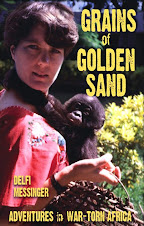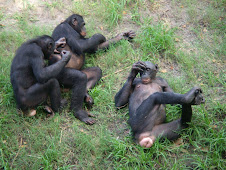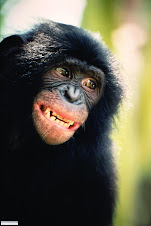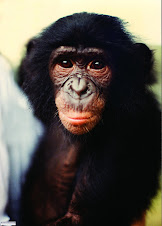skip to main |
skip to sidebar

 These are cowrie shells, from a mollusk (Cypraea moneta) found in the Indian ocean. Cowries represented the first and the most widespread currency (the American dollar is a contender for the golbal title today). The trade is no longer in existence, but the items above show how cowries were used as decoration in Africa. The object is a knife sheath, and consists of two pieces of wood encased in a woven fiber envelope and studded with glass beads and cowries.
These are cowrie shells, from a mollusk (Cypraea moneta) found in the Indian ocean. Cowries represented the first and the most widespread currency (the American dollar is a contender for the golbal title today). The trade is no longer in existence, but the items above show how cowries were used as decoration in Africa. The object is a knife sheath, and consists of two pieces of wood encased in a woven fiber envelope and studded with glass beads and cowries.
What makes a good currency? It needs to be portable, durable, easily divisible, difficult to counterfeit and from a limited source. Cowries met these criteria, although they were relatively heavy in bulk (in Africa, humans carried them across the continent). They are tiny and could be used as "small change" (in the 1700's, it took 25 to 32 cowrie shells to equal one farthing, the smallest currency in Britain).
There is evidence of export of cowries in the years BC, to China. The cowrie in China was so scarce that it was imitated in stone, jade, and gold. It was called "ant nose money" and used as an insert in the dead at burial, to prevent ants from entering the nostrils. Expanded export from the Maldive Islands began around the tenth century and shells were sent by the millions to Asia, Africa, and even Europe and to North America (although they were not used as money), The first cowries may have traveled as ballast in Arab dhows to the eastern coasts of Africa. In later years, the Portuguese and Dutch traded in cowries.
The Maldive Islands are a tiny country of over 1,100 islands, of which only 200 are inhabited. The total land surface of the Maldives is only one and a half times the size of the District of Columbia. The islands are located north of the Equator, south west of India.
The harvested and processing of cowries started with bundles of coconut fronds that were laid out in shallow lagoons. The rotting material collecting on the fronds attracted the mollusks to feed. Then the bundles were pulled out and spread in the sun to kill the animal inside the shells. Then, the cowries were buried in sand to decompose. Finally, the emptied shells were cleaned and shipped to foreign lands. The estimate is that there were 25 million pounds of cowries sent to the African continent between 1700 and 1800.
As other currencies, such metals coins and forged objects became popular, interest in cowries began to decline in the 18th century, although some tribes, such as the Bakuba of central Zaire (now the Democratic Republic of the Congo) appreciated the porcelain beauty of the shells. They continued to use cowries in their art, attaching them to belts, tapestries, rugs, and masks.
 The Polaroid camera I gave to the market informants enabled me to get snapshots of how business was transacted in Kinshasa, Zaire (now the Democratic Republic of the Congo). The upper left was of three stolen logs loaded in a metal cart. It would be sold to market women for firewood to brew the hard alcohol called lotoko.
The Polaroid camera I gave to the market informants enabled me to get snapshots of how business was transacted in Kinshasa, Zaire (now the Democratic Republic of the Congo). The upper left was of three stolen logs loaded in a metal cart. It would be sold to market women for firewood to brew the hard alcohol called lotoko.
In the top right, the smoked fish in the woven vine basket came from tributaries off of the Zaire River. Each basket weighed from 35 to 45 pounds and cost 650 million Zaires. At a rate of one million Zaires per US dollar, that was just over 72 dollars.
The lower left picture shows another scene at the market: a man has been hired to climb a palm tree to collect the palm nuts. In public places, a tree was "owned" and the fruits belonged to an individual or family. The last picture shows Kela, who sold potted plants and dried arrangements. He had other business on the side -- at the time of this picture he was trying unsuccessfully to sell monkeys to the Russians who were at the port in Matadi.
 This is tanapox, photographed in Zaire, now the Democratic Republic of the Congo. While sampling animals for monkeypox virus, I also collected mosquitoes along the banks of the Zaire River in the town of Lisala, where tanapox was seen. The theory was that the tanapox reservoir rested in small mammals (possibly monkeys) and mosquitoes were the vectors.
This is tanapox, photographed in Zaire, now the Democratic Republic of the Congo. While sampling animals for monkeypox virus, I also collected mosquitoes along the banks of the Zaire River in the town of Lisala, where tanapox was seen. The theory was that the tanapox reservoir rested in small mammals (possibly monkeys) and mosquitoes were the vectors.
Tanapox was first described in the late '50s along the Tana River in Kenya, where several hundred people were afflicted. It is found throughout tropical Africa, but is rarely seen. The virus can be cultured only in monkey and human tissue. A near identical disease is found in laboratory monkeys.
Like monkeypox, tanapox is a zoonosis, meaning that it is transmitted from an animal host. It is a double-stranded DNA poxvirus that starts with a fever, followed by a single hard nodule, usually on the extremities. Sometimes there are a few lesions, with a maximum of a dozen. Fortunately, patient recovery and resolution of the lesion(s) is the outcome. Tanapox occurs in males and females, of all ages and is not readily transmitted between people.
Only five cases of tanapox have been seen in the United States. Three of these came from contact with a laboratory animal, and one was a traveler from Sierra Leone. The most recent case was a 21 year-old college student who cared for orphaned chimpanzees for two months at a sanctuary in the Republic of the Congo. She exhibited a fever, swollen lymph glands and a lesion on an elbow and leg. She was first treated for malaria and then a local doctor attempted to aspirate material from a nodule, but it was solid.
Two weeks later, she returned to the states, where tanapox was suggested as a tentative diagnosis, which was confirmed by polymerase-chain-reaction (PCR).
Photo by World Health Organization

 This old map (someone wrote "1956" on it) was of the city I knew as Kinshasa, Zaire. The country was called the Belgian Congo and the city was then Leopoldville. It is still Kinshasa today, but the country was renamed the Democratic Republic of the Congo in 1997, after a military coup.
This old map (someone wrote "1956" on it) was of the city I knew as Kinshasa, Zaire. The country was called the Belgian Congo and the city was then Leopoldville. It is still Kinshasa today, but the country was renamed the Democratic Republic of the Congo in 1997, after a military coup.
The top image of the map is of the west (towards the Atlantic ocean) and the bottom is the eastern portion, including the downtown and the ports along the Congo River (seen as the grey area labeled Fleuve Congo) . The term used for the outlining shantytowns was cite indigene and this is the origin for the word cite,with an accent on the "e." All of the terrain that was blank on the map in the '50s is now occupied by the slums that stretch for miles and miles past the original borders of Kinshasa.
One landmark seen in the middle right section of the bottom map is the small airport called Sabena (for the Belgian airline). This is now the Ndolo airport which has small aircraft and cargo planes. This was also the scene of one of the most disastrous airline accidents ever, in January, 1996. On take-off, an overloaded Russian Antonov overshot the runway and plowed into a nearby market, killing roughly 300 people.

 I did a little of this and a little of that to make ends meet in Kinshasa, Zaire (now the Democratic of the Congo). The top image, a pen and ink drawing for the Bleu/Blanc magazine, was for an article about the local flies and pet dogs. The canine grimaces in pain as the biting flies buzz around its bleeding ears. The text recommends a daytime shelter (because the flies avoid the dark) and consulting a vet for a repellent product.
I did a little of this and a little of that to make ends meet in Kinshasa, Zaire (now the Democratic of the Congo). The top image, a pen and ink drawing for the Bleu/Blanc magazine, was for an article about the local flies and pet dogs. The canine grimaces in pain as the biting flies buzz around its bleeding ears. The text recommends a daytime shelter (because the flies avoid the dark) and consulting a vet for a repellent product.
The second image, taken from a pencil drawing, depicts the stripped hindquarters of the okapi, a giraffe for the Ituri region of the country. The okapi artwork was used for a school notebook that was distributed by the cellphone company called Telecel.
Art by D. Messinger
 The children's magazine received thousands of pieces of mail from readers, who answered the quiz questions, told us about themselves, and even mentioned how much they appreciated Bleu/Blanc.
The children's magazine received thousands of pieces of mail from readers, who answered the quiz questions, told us about themselves, and even mentioned how much they appreciated Bleu/Blanc.
The above was an opinion to a question on bonobo conservation. After many years, my French is rusty, but I translate the formal, stiff French of a student as the following:
"Yes, bonobos are really in danger of extermination. For my part, to furnish you with what I think, one must analyse what is the cause of their extermination. First, there is the deforestation: yes, as trees play an important role for man, and serves for many uses, notably in the timber industries, etc.... By consequence, we must also hold that if the habitual deforestation continues, there will be enormous consequences for the nature, for the environment, and certainly on the fauna. Thus the people there (the deforesters) must understand the consequences and try to assure the protection of the life of our chimpanzees (bonobos).
"Secondly, the poaching: we must add to poaching; the stupidity and superstition. But when we look at poaching or the hunting of these animals, we must know that this is tied to various reasons, notably thought of as a way of life or a fashion of living. Why is this?
"The communities that live on the borders (of the Park) also called riverains (river people) are poor, and for the most part, they are hit by the unemployment and the lack of sufficient food , in brief, all of these country people are neglected. By the fact that they don't have anything to do, the poaching of these animals notably, the bonobos, have become their job, which is stupid and superstitious.
"This is why the government must take measures for these previous citations, for example, supply jobs equally to these thousands of country people, particularly the riverains. To kill the bonobo for the reason to acquire power from magic rituals, I find this absurd and insignificant. And also, one must have these people know that they themselves are destroying a good part of our fauna... our treasure. Thus, I solicit the intervention of the government as quick as possible, especially for the specific cases, to forbid them seriously in a manner that their (bonobo) protection and conservation will be assured."
What amazes me is that in spite of the wordiness of his letter (students use a flowery French), this student expresses his ideas on risks to bonobos, which includes the use of animal parts for "magic." Typically, bonobo bones (from kills) or fingers and toes (from living infants taken from mothers) were put in babies bath water to "make them strong." He recommends a strong hand of the government to provide jobs and protect the bonobo.
 Lucy, a young bonobo at the Jacksonville Zoo and Gardens uses her teeth to tear apart a hunk of wood on exhibit. The curious and inventive bonobos investigate and use "found" objects in their environment to exercise, explore, and play.
Lucy, a young bonobo at the Jacksonville Zoo and Gardens uses her teeth to tear apart a hunk of wood on exhibit. The curious and inventive bonobos investigate and use "found" objects in their environment to exercise, explore, and play.
Photo by M. Brickner
 The children's magazine, Bleu/Blanc (for the blue and white uniform of students) was designed to create a thirst for reading, through stories, puzzles, cartoons, and quizzes. Natural history subjects on the local fauna and flora were mixed in with topics that were sought after by the readers, like relationships between boys and girls, scholastics, and health.
The children's magazine, Bleu/Blanc (for the blue and white uniform of students) was designed to create a thirst for reading, through stories, puzzles, cartoons, and quizzes. Natural history subjects on the local fauna and flora were mixed in with topics that were sought after by the readers, like relationships between boys and girls, scholastics, and health.
In the Congolese culture, animals were not valued, so even this special "bonobo" issue had other subjects to intice readers. We had to slip in the animal stories in small doses.
 This postcard illustrates a key mission of modern zoos -- to connect the zoogoer to animals in an impactful way. The use of glass enables the public to get very close to wild animals that they will never be able to appreciate in any other way. In the wild, an encounter such at this would be highly dangerous, yet in a zoo, it is a safe "thrill."
This postcard illustrates a key mission of modern zoos -- to connect the zoogoer to animals in an impactful way. The use of glass enables the public to get very close to wild animals that they will never be able to appreciate in any other way. In the wild, an encounter such at this would be highly dangerous, yet in a zoo, it is a safe "thrill."
Creating a connection to wildlife is a powerful tool for today's zoo. If a zoo links its animal collection to conservation projects in range countries, it comes full circle with an environmental message. The visitor can springboard from emotion (awe, admiration, respect) to actions (sustainable biodiversity). Actions do not have to be dramatic: "green" locally focused behaviors are a first positive step.

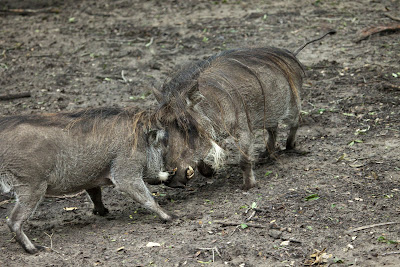
 You can't put a hog in a zoo--
You can't put a hog in a zoo--
There's no telling what he will do.
He may get loud
And charge at the crowd
Or just lie there not looking at you.
Roy Blount, Jr
The Jacksonville Zoo and Gardens has two female warthogs; a three year old female and an eleven year old female, who lost her companion last year. Warthogs are one of my favorite animals, because of their endearing "pigness." I used to raise pigs and enjoy watching the Zoo's warthogs acting like swine every time I visit them.
Pigs have a startle reaction to unusual situations, and they avoid confrontation by fleeing. The first reaction of a warthogs, also, is to try to escape by running away. They run with their tails stiffly raised, like a flag. The younger female is athletic and she sometimes shows off her racing form as she laps the exhibit early in the morning.
The pig family is social, and like all social species, there is always a hierarchy. The two "communicate" their differences head to head, through a series of squeals, grunts, low chattering, and high-pitched groans. They push each other fiercely, as if to test the other's ground hugging frame. The elder places her head high upon the younger's forehead, as if to say, "I'm the top hog here!"
But, after some jousting, the two make their peace, and settle down to the business of the day -- sleeping, plowing up the dirt in the yard, and waiting for the keeper to distribute a treat or two, which comes at odd times, and is pretty much hog heaven.
Photos by J. Reed


 These images are of wild bonobos that are being studied by Dr. Jo Thompson, Director of the Lukuru Wildlife Research Project. The first is a young male with his mother. Males stay with their mothers their entire lives, and their rank in the group is tied to her social status. A high ranking female will raise high ranking sons. (Daughters go "out into the world" when they reach puberty, and join another group).
These images are of wild bonobos that are being studied by Dr. Jo Thompson, Director of the Lukuru Wildlife Research Project. The first is a young male with his mother. Males stay with their mothers their entire lives, and their rank in the group is tied to her social status. A high ranking female will raise high ranking sons. (Daughters go "out into the world" when they reach puberty, and join another group).
The second photograph illustrates one of the saving fortunes for the bonobo. Because of its ability to walk upright for many strides, some local Congolese peoples will not kill or eat the bonobo. They tell stories about the closeness of humans to bonobos; that it is an "ancestor," saved the human ancestor, or was, once upon a time, a servant of man.
The last photograph shows two female bonobos in "G-G" rubbing, or "genito-genital" rubbing, one of many different positions and combinations of sex in the species. The species' frequent use of sexual relations (with or without penetration) serves to reduce tension whenever there is stress, such as competition over resources. In bonobo society, males and females, young and old, will pantomime sex as a greeting, as reassurance, or a "thank-you" in exchange for food.
In the bonobo world, females are dominant, and sisterly bonds will compel them to gang up on any male that would dare question their authority. This unique twist in the animal kingdom intrigues primatologists, sexual evolutionary scientists, and the rest of us.
Photos by R. Ross


 These awesome frogs are featured on a calender produced by the Amphibian project coordinated by several major international conservation groups and Zoos worldwide. Globally, amphibians are severely threatened by various threats including loss of habitat, pollution, climate change, and an infectious fungus called chytridiomycosis or "chytrid" (pronounced "kit-rid")
These awesome frogs are featured on a calender produced by the Amphibian project coordinated by several major international conservation groups and Zoos worldwide. Globally, amphibians are severely threatened by various threats including loss of habitat, pollution, climate change, and an infectious fungus called chytridiomycosis or "chytrid" (pronounced "kit-rid")
The first frog is a spiny-headed Treefrog, from cloud forests of central America. The male calls from pockets of water -- typically bromeliads or tree holes -- high up in the canopy. The female deposits her eggs just above the water line and when the tadpoles hatch, they wiggle free and drop into the water. The mother will return to the pool and lay unfertilized eggs, which her babies feed upon, and they become frogs in 60 days.
The second photograph is of an Ankafana Bright-eyed Frog from Madagascar. Lime-green, it blends with the foliage that it hides in during the day. The Bright-eyed frog is always found along streams in various habitats from degraded secondary to pristine primary forest. Luckily, this frog occurs in protected areas.
The last image is of the striking Australian Lace-lid Treefrog, with its unique eye camouflage, from North Queensland, Australia. It has disappeared from the uplands, but is still found at lower elevations, where it lives along fast-moving streams in the rainforest. The lace-lid was declared an endangered species in 1999, but the reason for its sharp decline is unknown.
Frogs are a diverse, beautiful group of animals that are important to ecosystems both for the prey (mostly insects) that they eat, and for being a food source for vertebrates. This represents a biological diversity crisis second only to the extinction of the dinosaurs.
Photos by B. Kubicki, P. Naskrecki, and J. Rowley
 CONNECT is the monthly magazine of the American Association of Zoos and Aquariums (AZA). In March, the giant otter was featured on the cover in an announcement about the species being displayed in a new exhibit at the Miami Metrozoo's Amazon & Beyond exhibit. Miami is only the fourth American facility to hold the charismatic giant otters, after the Philadelphia Zoo, the Dallas World Aquarium, and the Jacksonville Zoo and Gardens.
CONNECT is the monthly magazine of the American Association of Zoos and Aquariums (AZA). In March, the giant otter was featured on the cover in an announcement about the species being displayed in a new exhibit at the Miami Metrozoo's Amazon & Beyond exhibit. Miami is only the fourth American facility to hold the charismatic giant otters, after the Philadelphia Zoo, the Dallas World Aquarium, and the Jacksonville Zoo and Gardens.
The $50 million dollar project, now finished after two years of construction, showcases jaguars, howler monkeys, hummingbirds, Orinoco crocodiles, harpy eagles, giant anteaters, and fruit bats on 27 acres, which is divided into three sections -- Cloud Forest, the Amazon Forest, and the Atlantic Forest.

 These are cowrie shells, from a mollusk (Cypraea moneta) found in the Indian ocean. Cowries represented the first and the most widespread currency (the American dollar is a contender for the golbal title today). The trade is no longer in existence, but the items above show how cowries were used as decoration in Africa. The object is a knife sheath, and consists of two pieces of wood encased in a woven fiber envelope and studded with glass beads and cowries.
These are cowrie shells, from a mollusk (Cypraea moneta) found in the Indian ocean. Cowries represented the first and the most widespread currency (the American dollar is a contender for the golbal title today). The trade is no longer in existence, but the items above show how cowries were used as decoration in Africa. The object is a knife sheath, and consists of two pieces of wood encased in a woven fiber envelope and studded with glass beads and cowries.


















